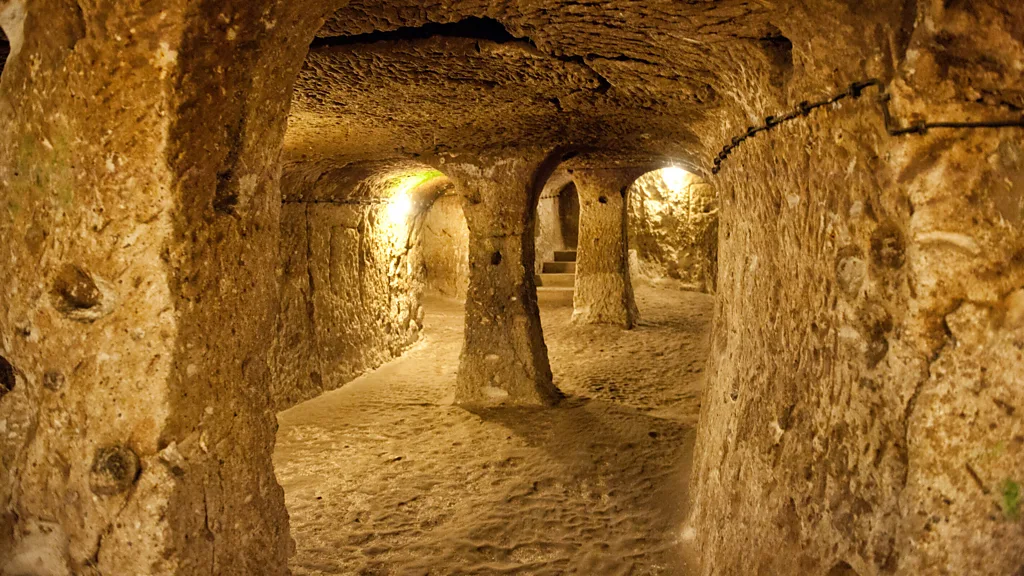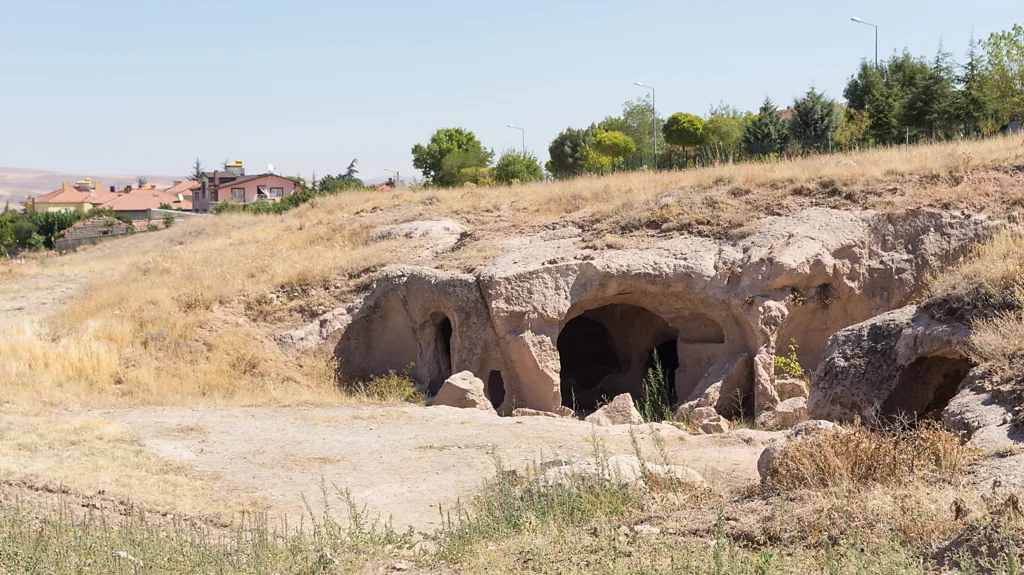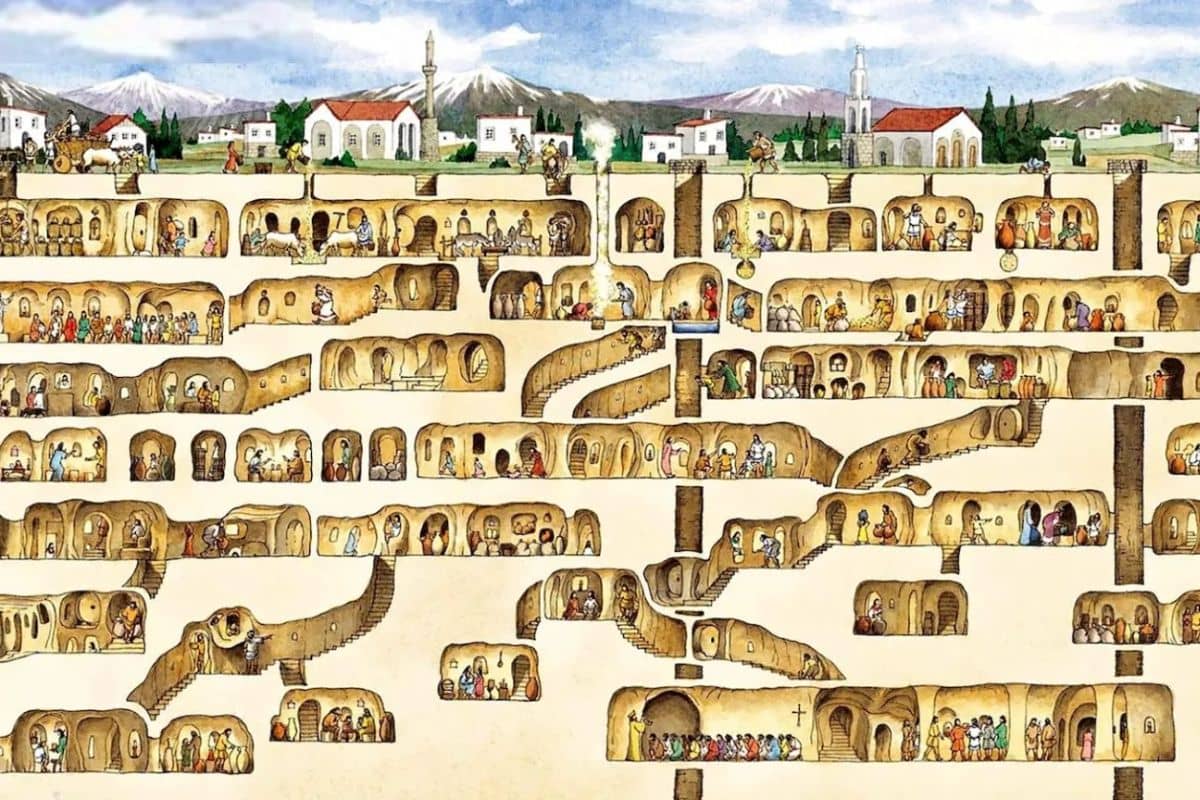Deep beneath the iconic fairy chimneys of Cappadocia, lies an expansive underground city that served as a refuge for thousands over millennia.
Violent gusts whipped loose soil into the air as I hiked through Cappadocia’s Love Valley. Pink- and yellow-hued hillsides colored the rolling landscape scarred with deep red canyons, and chimneystack rock formations loomed in the distance. It was arid, hot, windy, and breathtakingly beautiful. Millennia ago, this volatile, volcanic environment naturally sculpted the spires surrounding me into their conical, mushroom-capped shapes, which now draw millions of visitors to hike or hot-air balloon in the central Turkish region.
But beneath Cappadocia’s eroding surface, an equally monumental marvel lay hidden for centuries; a subterranean city that could house up to 20,000 inhabitants for extended periods.
The ancient city of Elengubu, now known as Derinkuyu, extends more than 85m below the Earth’s surface, encompassing 18 levels of tunnels. The largest excavated underground city globally, it was in frequent use for thousands of years, changing hands from the Phrygians to the Persians to the Christians of the Byzantine Era. It was finally abandoned in the 1920s by the Cappadocian Greeks when they fled en masse to Greece following their defeat in the Greco-Turkish war. Not only do its cave-like rooms stretch on for hundreds of miles, but it’s thought the more than 200 small, separate underground cities that have also been discovered in the region may be connected to these tunnels, creating a massive subterranean network.
According to my guide, Suleman, Derinkuyu was “rediscovered” in 1963 by an anonymous local who kept losing his chickens. While renovating his home, the poultry would disappear into a small crevasse created during the remodel, never to be seen again. Upon closer investigation and some digging, the Turk unearthed a dark passageway. This was the first of more than 600 entrances found within private homes leading to the subterranean city of Derinkuyu.
Excavation began immediately, revealing a tangled network of underground dwellings, dry food storage, cattle stables, schools, wineries, and even a chapel. It was an entire civilization safely tucked underground. The cave city was soon explored by thousands of Turkey’s least claustrophobic tourists and, in 1985, the region was added to the UNESCO World Heritage list.

The city’s exact date of construction remains debated, but Anabasis, written by Xenophon of Athens around 370 BCE, is the oldest known work that seems to reference Derinkuyu. In the book, he mentions Anatolian people, in or near Cappadocia, living underground in excavated homes rather than the more popular cliffside cave dwellings that are well-known in the area.
Andrea De Giorgi, associate professor of classical studies at Florida State University, explained that Cappadocia’s unique geology is conducive to this kind of underground construction due to the lack of water in the soil and its easily moldable rock. “The geomorphology of the region is conducive to the digging of underground spaces,” he said, noting that the local tuff rock would have been fairly easy to carve with simple tools like shovels and pickaxes. This same pyroclastic material was naturally forged into the fairy-tale chimneys and phallic spires jutting from the earth above ground.
Credit for Derinkuyu’s creation remains partially mysterious. The groundwork for the sprawling network of subterranean caves is often attributed to the Hittites, “who may have excavated the first few levels in the rock when they came under attack from the Phrygians around 1200 BCE,” according to A. Bertini, an expert in Mediterranean cave dwellings, in his essay on regional cave architecture. Adding weight to this hypothesis, Hittite artifacts were found inside Derinkuyu.
However, the bulk of the city was likely built by the Phrygians, highly skilled Iron-age architects who had the means to construct elaborate underground facilities. “The Phrygians were one of Anatolia’s most prominent early empires,” explained De Giorgi. “They developed across western Anatolia around the end of the first millennium BCE and had a talent for monumentalizing rock formations and creating remarkable rock-cut facades. Though elusive, their kingdom spread to include most of western and central Anatolia, including the area of Derinkuyu.”

Initially, Derinkuyu served as a storage site, but its primary function was a refuge from foreign invaders, with Cappadocia witnessing a constant shift of ruling empires over the centuries. “The succession of empires and their impact on the landscapes of Anatolia explain the recourse to underground shelters like Derinkuyu,” De Giorgi stated. “It was during the [7th-Century] Islamic raids [on the predominantly Christian Byzantine Empire] that these dwellings were utilized to the fullest.” The Phrygians, Persians, Seljuks, and others expanded upon the underground city over the centuries. Derinkuyu’s population peaked during the Byzantine Era, with nearly 20,000 residents living underground.
Today, you can experience the stark reality of life underground for just 60 Turkish lira (£2.80). As I descended into the musty, narrow tunnels, with walls blackened from centuries of torch lighting, an unfamiliar sensation of claustrophobia began to set in. However, the ingenuity of the various empires that expanded Derinkuyu soon became apparent. Intentionally narrow and short hallways forced visitors to navigate the labyrinth of corridors and dwellings while stooped over and in single file – obviously an awkward position for intruders. Dimly lit by lamplight, half-ton circular boulders blocked doors between each of the 18 levels and were only moveable from the inside. Small, perfectly round holes in the center of these hefty doors would have allowed residents to spear invaders while maintaining a secure perimeter.
“Life underground was probably very difficult,” my guide Suleman remarked. “Residents relieved themselves in sealed clay jars, lived by torchlight, and disposed of dead bodies in designated areas.”
Each level of the city was carefully designed for specific purposes. Livestock was kept in stables nearest to the surface to reduce the smell and toxic gases produced by cattle, as well as to provide a warm layer of living insulation for the cold months. The inner layers of the city contained dwellings, cellars, schools, and meeting spaces. Identifiable by its unique barrel-vaulted ceilings, a traditional Byzantine missionary school, complete with adjacent rooms for study, is located on the second floor. According to De Giorgi, “the evidence for winemaking is grounded in the presence of cellars, vats for pressing, and amphoras [tall, two-handled jars with a narrow neck].” These specialized rooms indicate that inhabitants of Derinkuyu were prepared to spend months underground.

Most impressive is a sophisticated ventilation system and protected well that would have supplied the entire city with fresh air and clean water. In fact, it is believed that the early construction of Derinkuyu centered around these two essential elements. More than 50 ventilation shafts, which allowed for natural airflow between the city’s many dwellings and hallways, were distributed throughout to avoid a potentially fatal attack on their air supply. The well was dug more than 55m deep and could be easily cut off from below by the city inhabitants.
While Derinkuyu’s construction was indeed remarkable, it is not the only underground city in Cappadocia. At 445 sq km, it is merely the largest of the 200-plus underground cities beneath the Anatolian Plains. More than 40 of these smaller cities are three or more levels deep. Many are connected to Derinkuyu via carefully dug tunnels, some stretching as long as 9km. All of them are equipped with emergency escape routes in case an immediate return to the surface was necessary. But Cappadocia’s subterranean mysteries have not yet all been unearthed. In 2014, a new and potentially even larger underground city was discovered beneath the Nevsehir region.
Derinkuyu’s story ended in 1923 when the Cappadocian Greeks evacuated. More than 2,000 years after its likely creation, Derinkuyu was abandoned for the last time. Its existence was all but forgotten until some errant chickens brought the subterranean city back into the light.






